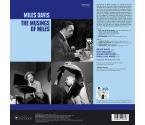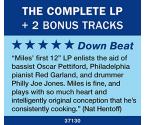Restiamo in contatto
Miles Davis - The Musings of Miles -- LP 33 giri 180 gr Made in EU - De Luxe Limited edition
Miles Davis - The Musings of Miles -- LP 33 giri 180 gr Made in EU - De Luxe Limited edition
JIM0001LP
Descrizione
.gif) | .gif) | ||
| Etichetta | Jazz Images 37130 | Label | |
| Titolo | The Musings of Miles | Title | |
| Artista | Miles Davis | Artist | |
| Tracklist | VEDI descrizione ( e/o foto) | SEE description (and/or photos) | Tracklist |
| Vinile | SIGILLATO | SEALED | Vinyl |
| Cover | SIGILLATO | SEALED | Cover |
| Supporto | LP 33 giri 180 gr | LP 33 rpm 180 gr | Support |
| Made in | EU | Made in | |
| Stampa del | 2019 | Pressing | |
| Note Descrizione | The Musings of Miles, recorded in a quartet format with Miles as the only horn, also features Red Garland on piano, the great Oscar Pettiford on bass, and Philly Joe Jones on drums. Part of the rhythm section of this quartet became the nucleus of the group that would later be known as Miles’ “First Great Quintet”. Garland and Jones would soon be in Miles’ group, although the fiery Pettiford proved too difficult for the trumpeter to handle and was quickly succeeded by Paul Chambers. The set contains four standards, a blues titled “Green Haze” and Miles’ tune “I Didn’t”, which was the trumpeter’s humorous response to Thelonious Monk’s “Well You Needn’t”. “A Night in Tunisia” features Philly Joe Jones playing with special drum sticks which had bells riveted to the shaft. The only other two quartet recordings by Miles with Oscar Pettiford have been added here as a bonus. PERSONNEL:
Hackensack, New Jersey, June 7, 1955. BONUS TRACK
SIDE A:
SIDE B:
One of the most renowned jazz photographers of all time, Francis Wolff (1907-1971) was also a record company executive and producer, whose skills were essential to the success of the Blue Note record label. Born Jakob Franz Wolff in Berlin, Germany, he soon became a jazz enthusiast, despite the government ban placed on this type of music after 1933. A Jew, in 1939 he left Berlin, where hehad worked as a commercial photographer, and established himself in New York. He began working there with his childhood friend Alfred Lion, who had co-founded Blue Note Records with Max Margulis. The latter soon dropped out of any involvement in the company, and Wolff joined Lion in running it. Wolff took thousands of photographs during the label’s recording sessions and rehearsals. His highly personal visual concept would be forever associated with both Blue Note and jazz as a whole. | Notes Description | |



